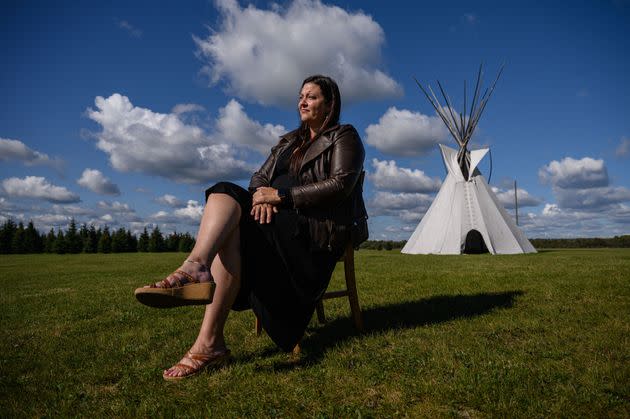This Indigenous Community Created A New Blueprint To Fight Climate Change

ThispastApril, the Métis Nation held the first Youth Summit on Climate Change, highlighting and celebrating just how strong Métis activism still is. I was invited there to speak on a panel about how storytelling is, and has always been, an important tool for mitigating climate change and healing nature.
At the summit, I was surrounded by brilliant Métis and First Nations youth activists from across Turtle Island, also known as North America. I felt immersed in the powerful energy of young minds gathering to collaborate, learn, and tell stories that reinforce our commitment to the environment.
If you live south of the Canada-U.S. border, it’s entirely possible that you have not heard of the Métis peoples. Any time I’ve spoken this term after moving from Canada to New York City, I’ve been met with confused expressions, whether I’m talking to Natives or non-Natives.

There was a time when Métis were referred to as halfbreeds. In the U.S., your right to Native identity is measured in blood quantum, a hotly debated concept that the measurement of how much “Indian blood” you have dictates the authenticity of your lineage. Traditional Native communities, however, practiced from kinship systems, which establish community through mutual obligation rather than blood relations. This means that tribes would “adopt” members, so to speak, based on community involvement.
In Canada, a distinct cultural group emerged from Natives and European settlers having children together and building community. However, that doesn’t mean anyone with mixed European and Native heritage qualifies. The term “Métis” refers to a distinctive mixed peoples who developed their own customs, language, ways of life, cultural practices and recognizable group identity. There are no blood quantum requirements, but Métis rights holders must have ancestral connections to a historic Métis community.
In 1982, Métis peoples were constitutionally recognized as a distinct Indigenous group, alongside the First Nations and Inuit. Originally, Métis were going to be left out of the new constitution because they were not federally recognized as Natives in the Indian Act, a piece of legislation created to control Indigenous peoples in Canada. But Indigenous activists from around the country gathered, demonstrated, and stormed Parliament, demanding recognition. Among those activists was my great-grandmother, waving her Métis flag across the country. Those activists fought against systems of erasure that have always tried to eradicate Indigenous peoples from our lands and extinguish our very existence.
The Métis lived in the land that’s now Canada before it was named as such in 1867, and they served as liaisons at the heart of the fur trade, having a foot in both the European and Native worlds. They have always played a pivotal role in land protection and land conservation, and so the work done at the summit felt like an organic space for activism.
“The impacts of climate change continue to be keenly felt by the Métis Nation,” said Cassidy Caron, president of the Métis National Council. “Now, more than ever, it is vital that we work together to protect and preserve the land, water, and air, and to develop and advance strategies to deal with the environmental issues that affect us all.”
Outside of organizing, the purpose of the Youth Summit was to unveil the Climate Action Strategy that Métis governments across Canada and the Métis National Council had been developing for the past few years. From all over the country, Métis artists, activists, policy workers, local government officials and more all collaborated on plans to find and nurture clean and renewable energy, and encourage international advocacy and climate leadership.
One immediate action item was the transition of infrastructure and energy systems to achieve net-zero carbon emission by 2050. Among the initiatives born out of this goal is the Métis Crossing Solar Project in Alberta’s Smoky Lake County ― a collaboration between MNA, the county, and the town of Smoky Lake. While most electricity grids are powered by generators fueled with coal and natural gas, this model for community-scale solar generation reduces greenhouse gas emissions through partnership with Indigenous communities.
Métis science and technology adviser Brendan Struthers, who attended the summit, described to me some of the direct effects climate change has had on his community, which led him to relocate.
“When I was young, minor events may have happened once every five years,” he told me. “Now, it’s an expectation that nearly every year we will experience a severe wildfire and/or drought. In the Okanagan, it’s now too difficult to live with the smoke, and I could no longer rely on the water because lake levels would be too low or not safe to fish.”
The climate strategy aims to address these kinds of disruptions to everyday life ― Struthers’ experience is only one among a sea of people navigating this crisis. It’s an ugly truth that as much displacement as our communities have faced historically, there will be even more to come if our land is robbed of resources.
We all walked away with something that made us feel empowered, even amid the chaos of the constant abuse of our planet: a plan to address climate change that is actionable and focused. Its five priorities are economic development and prosperity; nature stewardship; sustainable energy and infrastructure; emergency management and climate resilience; and health and well-being. Each priority outlines long-term outcomes and proposes a list of actions to achieve those goals, to be executed in tandem between community members and government officials.
The entire creation of the strategy is a celebration of Métis collaboration and agency. After the climate conversations came parties and performances by members of the community. The artwork displayed at the summit was selected based on an art competition held by the Métis National Council.
“I aspire for my artwork to encapsulate the urgency of strategizing against climate change,” said artist Teagan Neufeld, who designed the cover for the climate change action strategy. “We must unite to navigate the flames and emerge on the other side before the fire engulfs us all. I hope future generations will look back on their childhood with the same fondness for nature that I do. There is an abundance we must safeguard and advocate for.”

